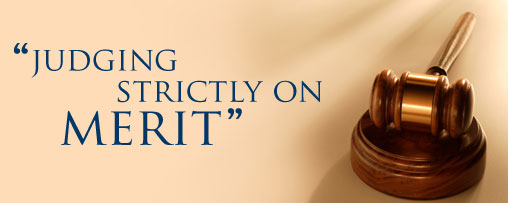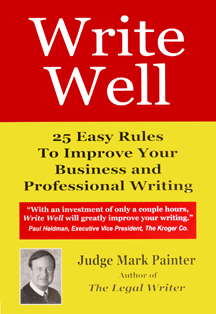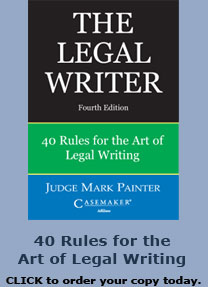Good Writing Needs a Good ‘Look’
By Judge Mark P. Painter
|
What an odd phenomenon it is that lawyers – whenever it is that they want to draw special attention to passages, such as main issues in a brief or warnings in drafted documents – make them typographically impenetrable. Bryan A. Garner, A Dictionary of Modern Legal Usage 130 (2nd ed. 1995) Lawyers and judges seem to find ways to make writing difficult to read. We have discussed nominalization, the use of the passive voice, long sentences and paragraphs, and using two or three words when one will do. But we also tend to make the words physically hard to read. Because we are usually trying to persuade the reader, we should make it easy. This includes visually, as well as mentally. The typestyle, the visual makeup of the page, and the general look and visual “feel” of the document add to – or detract from – readability. Unreadable Fonts Sometimes we invest in great word-processing technology, then insist on having our writing appear as if produced on a 1940 Underwood. Courier is the most difficult to read of any normal font. This is because it is monospaced, rather than proportional. Typewriters required this spacing. Our word processors do not. Do you remember ever reading a book in Courier? Long ago, some courts even made us have our briefs printed – because typescript is notoriously unreadable. Monospaced type should only be used when there is no other choice. Contrast this with: Courier is the most difficult to read of any normal font. This is because it is monospaced, rather than proportional. Typewriters required this spacing. Our word processors do not. Do you remember ever reading a book in Courier? Long ago, some courts even made us have our briefs printed – because typescript is notoriously unreadable. Monospaced type should only be used when there is no other choice. Never use Courier, unless you want your document to look as if it were typed in 1940. Times New Roman (TNR) is now the default font on most word processors. But that need not dictate your style. One problem with TNR is that the periods and commas are too small – they are sometimes difficult to see. This sentence is in TNR. This is in Georgia. TNR was developed for the London Times. Because ink tends to expand in newsprint, the periods and commas – and the type itself – appear larger and darker. Our printers don’t bleed, so TNR is not the best font. After much research – I’ve conducted tests with hundreds of people in my seminars – Georgia is my choice. Georgia was developed for the Internet, so it is much easier to read. Palatino, Baskerville, and Garamond are also good for text, though each has some good and bad points. All are serified type. Not unreadable but not as readable is a sans serif font. Serifs are the “wings” at the bottom and top of the letters – look at the a, f, d, f, h, i, k, l, m, n, p, q, r, u, v, w, x, and y. The serifs guide the reader’s eyes horizontally – which is the way we read text. Scientific studies support always using a serif type for text. On the other hand, a sans serif type – wings – guides the eyes vertically. Some common sans serif types are Arial, Lucinda Sans, and Tahoma. You should use one of them for headings and titles in your document. And to further set off the headings, make them bold. I use Arial bold italic. Avoid All Caps Never use all caps, unless a specific format absolutely requires it. Text in all caps is very difficult to read: WE GAVE JUDGE PAINTER‘S BOOK TO EVERY ATTORNEY IN OUR OFFICE, AND REQUIRE OUR ATTORNEYS TO FOLLOW JUDGE PAINTER‘S 40 RULES. OUR WRITING IS NOW MORE EFFECTIVE AND PERSUASIVE. SUBODH CHANDRA. DIRECTOR OF LAW, CITY OF CLEVELAND (UNTIL 12-31-04) Compare this with: We gave Judge Painter‘s book to every attorney in our office, and require our attorneys to follow Judge Painter‘s 40 rules. Our writing is now more effective and persuasive. Subodh Chandra, Director of Law, City of Cleveland (until 12-31-04) Which is easier to read? Capital letters not only scream, they cut off the ups and downs of letters – the q, t, y, p, d, f, g, h, j, k, l, and b that our eyes recognize below or above the line – the shapes that give clues to the words. With all caps our eyes – and brain – must struggle. If you want to emphasize a phrase or a sentence, either (1) write it well enough that it supplies its own emphasis, or (2) use bold, not caps or italics. Because italic type cuts down on reading speed, italics should be reserved for case names. Don’t Underline Underlining is almost as bad as all caps – for the same reason. Though it only obscures the down part of the letters, that’s bad enough. Underlining is a signal to the printer that the words should be italicized. Our 1940s typewriters wouldn’t do italics, so we had to underline as a poor substitute – but now there is no excuse. Once when I was teaching legal writing at the University of Cincinnati College of Law, a student told me that a professor, in addition to her boss at the law firm where she worked, had said to use underlining because it stood out better. My response: yes, it will stand out that you don’t know what you’re doing. The same is true as with Courier type – have you ever seen underlining in a book? Don’t Use Too Many Caps Lawyers tend to capitalize the initial letter of too many words – especially Court and Judge. But only the U.S. Supreme Court is always capitalized, and judge is only capitalized as part of a name – Judge Edwina Parsons. In the past, there was a time when many nouns were capitalized. We hold these truths to be self-evident, that all men are created equal, that they are endowed by their Creator with certain unalienable Rights, that among these are Life, Liberty and the pursuit of Happiness. -That to secure these rights, Governments are instituted among Men, deriving their just powers from the consent of the governed, -That whenever any Form of Government becomes destructive of these ends, it is the Right of the People to alter or to abolish it, and to institute new Government, laying its foundation on such principles and organizing its powers in such form, as to them shall seem most likely to effect their Safety and Happiness. Perhaps the capitalizations were for emphasis. But the modern trend is against capitalization of anything except proper names. Avoid Narrow Margins Studies show that written text should contain about 50 percent white space. That’s not as hard as it sounds. Use at least 1.25-inch margins, and you will be home free. Unfortunately, with our standard 8.5 x 11-inch paper, this still leaves 6.0 inches of type. That’s a bit longer than ideal for reading – which, at a 12pt font, is columns between 2.75 and 4 inches. You are reading this article in smaller type, in a column format. But with standard typescript, one-inch margins decrease readability by about 3 percent, so use at least 1.25 inch, and maybe 1.4. Readability Stats In each column, I list the two major readability statistics – remember that you can program Word to tell you these and more. Statistics for this column: 15 words per sentence, 9 percent in the passive voice. (Remember the 1818 Rule – no more than an average of 18 words per sentence and 18 percent passive-voice sentences.) |
____________________________________
Mark Painter has served as a judge on the Ohio First District Court of Appeals for 10 years, after 13 years on the Hamilton County Municipal Court. He has served as an Adjunct Professor at the University of Cincinnati College of Law since 1990. Judge Painter is the author of five books, including The Legal Writer: 40 Rules for the Art of Legal Writing. The book is available from http://books.lawyersweekly.com. Judge Painter has given dozens of seminars on legal writing, and will give his six-hour legal writing seminar on March 4 in Charleston, W. Va., March 25 in Dayton, Ohio, April 28 in Cleveland, May 6 in Indianapolis, June 16 in Louisville, Ky., and June 17 in Lexington, Ky. Contact him through his website www.judgepainter.org.








